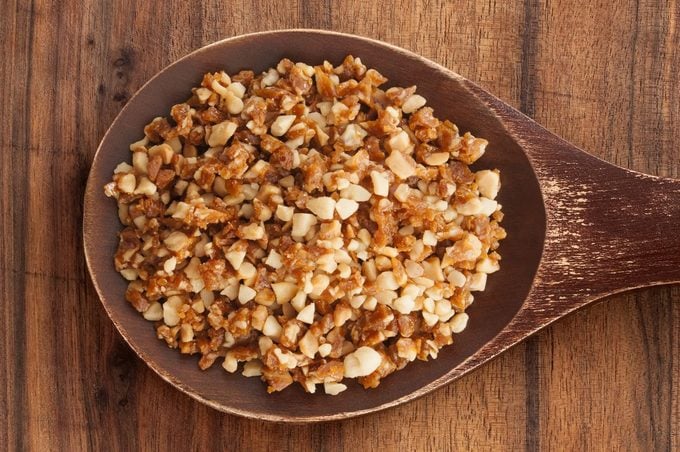What Are Pralines, Exactly?
Updated: Jul. 17, 2023

What are pralines if not the perfect sweet and creamy treat? Here's everything you need to know about this favorite Southern candy.
While we can all agree that pralines are an indulgent and delicious candy, things start to get tricky from there. The ingredients, look and texture can vary, depending on where you get them, and people in the United States even pronounce the word differently, depending on where they live. It all begs the question: What are pralines made of, and how can you whip up a batch yourself?
We’ve got all the info you need to know about the mouthwatering treat Georgians consider the best snack in the state and the rest of America regards as a must-try candy. We’ll touch on where they came from (Europe? America?), how to make them (do you need almonds, pine nuts, peanuts or pecans?) and, yes, how to pronounce them. So grab a handful of pralines (or two scoops of praline ice cream) and settle in for some sweet food facts about your new favorite snack.
Get Reader’s Digest’s Read Up newsletter for more food explainers, humor, cleaning, travel, tech and fun facts all week long.
What are pralines?
While there are a few different types of pralines, they all have a few things in common. First, all pralines are candies and are typically bite-size or just a bit bigger. Most feature nuts and caramel, though some use chocolate instead.
The original praline is the French praline—think almonds covered in a creamy caramel coating. The American version, which was created in New Orleans, is similar, though the almonds were replaced with pecans. American candymakers often play with the flavors, adding vanilla flavoring, coconut or chocolate.
Travel to Europe today, and you’ll find the now-popular Belgian praline, which more closely resembles a chocolate truffle. The creamy filling is usually a blend of cocoa and ground nuts, and it’s enclosed in a chocolate coating.
The history of pralines
Pralines were invented in France in the 1600s. It is widely accepted that the creator of the praline was the French pastry chef Clement Lassagne, who at the time was personal chef to the comte du Plessis-Praslin (you can see the praline’s namesake there). There are a few different accounts of how the treat was created—some feature accidents, some purposeful invention—but Lassagne is considered the father of the praline.
Not long after, in the early 1700s, French nuns began to arrive in New Orleans, bringing with them the knowledge of how to make these vintage candies. There weren’t many almonds in Louisiana, but there was a plethora of pecans. So candymakers substituted one nut for the other, creating the pecan pralines Americans know today.
Given that they’ve been popular in New Orleans for 300 years, this Southern port city is where you’ll find the most candymakers churning out pralines. If you’re in New Orleans or looking to order pralines online, we recommend Southern Candymakers, Aunt Sally’s Creole Pralines, Loretta’s Authentic Pralines, Laura’s Candies or Leah’s Pralines.
That said, a few other Southern cities have made a name for themselves making pralines. Most notable is Savannah’s Candy Kitchen, a candy shop with eight locations across Georgia, South Carolina, Tennessee and Maryland that’s become known nationwide for its pralines.
What do pralines taste like?

A traditional American praline is sweet, creamy and delicious. It has a rich caramel flavor, and the pecans add a touch of savory crunchiness. No wonder so many people cite it as their favorite candy.
In terms of texture, a praline lands somewhere between a soft caramel and brittle candy: not so soft that you can squish it between your fingers, but not so hard that it’s difficult to bite. (Candymakers achieve this by cooking the caramel to the correct temperature before adding the nuts.)
What’s the difference between a pecan and a praline?
Pecans are the main ingredient in American pralines. Some pralines are made with pecan halves, while others use smaller, chopped-up pieces of pecans. Either way, without the pecans, pralines would just be balls of creamy caramel.
Another answer to the question “What are pralines?” helps explain the difference between the two terms: Pralines are also known as pecan pralines or pecan patties.
What’s the difference between candied pecans and pralines?
Pralines are sometimes referred to as pecan candy, so it’s no surprise that candied pecans and pralines are commonly confused foods. Candied pecans, which you can eat as a snack or use as a topping on salads or in desserts, are made by coating pecan halves in a cinnamon-and-sugar mixture and then baking or frying them until they’re crunchy and sweet.
Pralines, on the other hand, are made by cooking caramel on the stove, adding pecan halves or pieces, and then scooping spoonfuls out and placing them onto a baking sheet to set.
How do you make pralines?
While you can buy pralines at a candy shop or purchase them online from one of the New Orleans institutions above (many even come with instructions for how to make them taste like they are freshly made), you can also make them at home.
To make pralines, you’ll need a large pot, a candy thermometer and a large baking sheet or section of counter that you can cover with wax paper.
The first step is to make caramel on the stove, usually with some combination of sugars (such as granulated sugar, brown sugar or corn syrup) and dairy (such as cream or evaporated milk). Cook these ingredients until the temperature on a candy thermometer reads between 230 and 240 degrees. Next, stir in butter, pecans and vanilla extract. Then scoop large spoonfuls of the mixture onto the wax paper to set. After about 30 minutes, you’ll have a perfect batch of pralines!
How do you pronounce praline?
Travel around the United States, and you’ll hear two different pronunciations of praline (just like there are two different pronunciations of pecan). In New Orleans and along the Gulf Coast, where French immigrants first introduced pralines to Americans, it’s pronounced prah-leen, with a long ahh sound, which is closest to the French pronunciation. But go west into Texas, east to Georgia or further north, and you’ll likely hear it pronounced pray-leen, which is a more anglicized pronunciation.
Considering that pralines originated in French and were first made in the United States in New Orleans, their pronunciation is technically the correct one. But if you use the anglicized version, everyone is going to know that you’re talking about the pecan candy.
Now that you can expertly answer “What are pralines?” the next time someone asks, get ready for even more food knowledge: Find out what marshmallows are made of and learn all about white chocolate.
Source:
- Southern Candymakers: “History of the Praline”






















